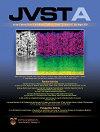Angle resolved x-ray photoelectron spectroscopy assessment of the structure and composition of nanofilms—including uncertainties—through the multilayer model
IF 2.1
3区 材料科学
Q3 MATERIALS SCIENCE, COATINGS & FILMS
引用次数: 0
Abstract
The multilayer model (MLM) for assessing the structural and composition parameters of multilayered nanofilms from angle-resolved x-ray photoelectric spectroscopy is described in detail. It is compared with regularized back-transform (RBT) approaches such as the maximum entropy method (MEM) with Tikhonov-type regularizations. The advantages of MLM over MEM, such as the possibility of assessing confidence ranges, modeling structures beyond conformal multilayered nanofilms, and modeling abrupt interfaces, are discussed and exemplified. In contrast with MLM, the RBT methods have shortcomings such as the violation of the conservation of information and the inability to adequately address the dependence of the effective attenuation length on the material. Examples of the application of MLM to conformal films and systems with protrusions are shown. The covariance matrix method (CMM) is described and applied to assess uncertainties in structural parameters and composition under the MLM. The CMM constitutes the canonical method for assessing confidence ranges and adequately accounts for the covariance among structural (e.g., layer thicknesses) and composition parameters.角分辨x射线光电子能谱评估纳米膜的结构和组成-包括不确定度-通过多层模型
详细介绍了用角分辨x射线光电光谱技术评价多层纳米膜结构和组成参数的多层模型。并将其与正则化反变换(RBT)方法(如具有tikhonov型正则化的最大熵法(MEM))进行了比较。本文讨论并举例说明了MLM相对于MEM的优点,如评估置信范围的可能性、对保形多层纳米膜以外的结构进行建模以及对突然界面进行建模。与MLM相比,RBT方法存在诸如违反信息守恒和无法充分解决有效衰减长度对材料的依赖等缺点。给出了在保形膜和凸体系统中的应用实例。介绍了协方差矩阵法(CMM),并应用该方法对结构参数和组成的不确定性进行了评估。CMM构成了评估置信范围的典型方法,并充分说明了结构(例如,层厚度)和组成参数之间的协方差。
本文章由计算机程序翻译,如有差异,请以英文原文为准。
求助全文
约1分钟内获得全文
求助全文
来源期刊

Journal of Vacuum Science & Technology A
工程技术-材料科学:膜
CiteScore
5.10
自引率
10.30%
发文量
247
审稿时长
2.1 months
期刊介绍:
Journal of Vacuum Science & Technology A publishes reports of original research, letters, and review articles that focus on fundamental scientific understanding of interfaces, surfaces, plasmas and thin films and on using this understanding to advance the state-of-the-art in various technological applications.
 求助内容:
求助内容: 应助结果提醒方式:
应助结果提醒方式:


